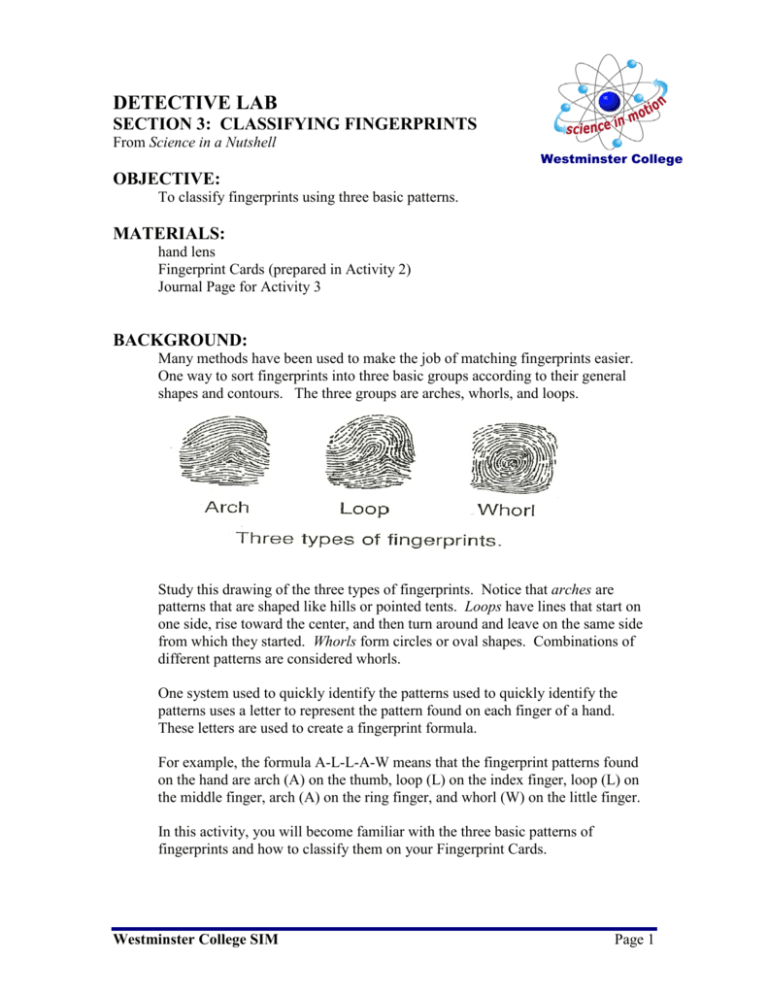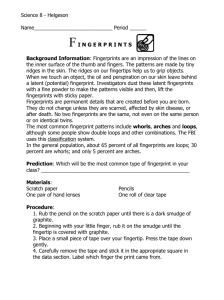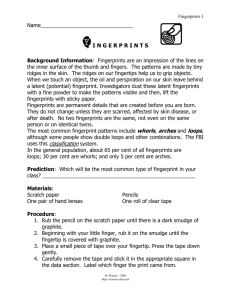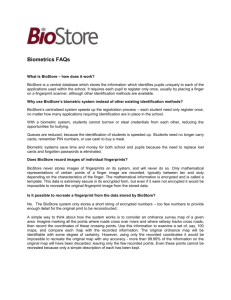classifying fingerprints
advertisement

DETECTIVE LAB SECTION 3: CLASSIFYING FINGERPRINTS From Science in a Nutshell Westminster College OBJECTIVE: To classify fingerprints using three basic patterns. MATERIALS: hand lens Fingerprint Cards (prepared in Activity 2) Journal Page for Activity 3 BACKGROUND: Many methods have been used to make the job of matching fingerprints easier. One way to sort fingerprints into three basic groups according to their general shapes and contours. The three groups are arches, whorls, and loops. Study this drawing of the three types of fingerprints. Notice that arches are patterns that are shaped like hills or pointed tents. Loops have lines that start on one side, rise toward the center, and then turn around and leave on the same side from which they started. Whorls form circles or oval shapes. Combinations of different patterns are considered whorls. One system used to quickly identify the patterns used to quickly identify the patterns uses a letter to represent the pattern found on each finger of a hand. These letters are used to create a fingerprint formula. For example, the formula A-L-L-A-W means that the fingerprint patterns found on the hand are arch (A) on the thumb, loop (L) on the index finger, loop (L) on the middle finger, arch (A) on the ring finger, and whorl (W) on the little finger. In this activity, you will become familiar with the three basic patterns of fingerprints and how to classify them on your Fingerprint Cards. Westminster College SIM Page 1 CLASSIFYING FINGERPRINTS EXPERIMENT: 1. Look at the print on your right thumb on your Fingerprint Card. Is it an arch, loop, or whorl? Use A for arch, L for loop, W for whorl. Record your thumb pattern on the Journal page for Activity 3. 2. In your journal, record the letters for the patterns found on the fingers of your right hand. 3. On the journal page, record the letters for the patterns on the thumb and fingers of your left hand. 4. Also, write the formula for the fingerprints of each hand. Remember to use the letters, A, L, or W and to start with the thumb. W – L -- L -- A -- L A Fingerprint formula. 5. Which pattern is most common on your fingers? Which pattern is the least common? Record your findings in your journal. 6. Look at the other nine Fingerprint Cards that you made in Activity 2. Examine each print and record the code for the pattern of each print. 7. Determine the fingerprint formula for each hand of the nine other people. Record each person’s formula on his or her Fingerprint Card. 8. Use the fingerprint formulas to count the total number of arches, whorls, and loops found on your fingerprints and those of the other people. 9. Examine your records to see which type of fingerprint is most common: arches, whorls, or loops. Which group is the least common? Record your findings in your journal. IN A NUTSHELL: • • A fingerprint formula is a list of letters that shows the fingerprint patterns found on one hand, beginning at the thumb and going to the little finger. If you were to count the types of fingerprints found on everyone in the United States, you would find that there are about twice as many loops as whorls, and very few arches. CRACKING THE NUT: On a separate sheet of paper, secretly make a mystery print of one of your fingers. Challenge your partner to correctly identify which finger you used to make the mystery print. Westminster College SIM Page 2











